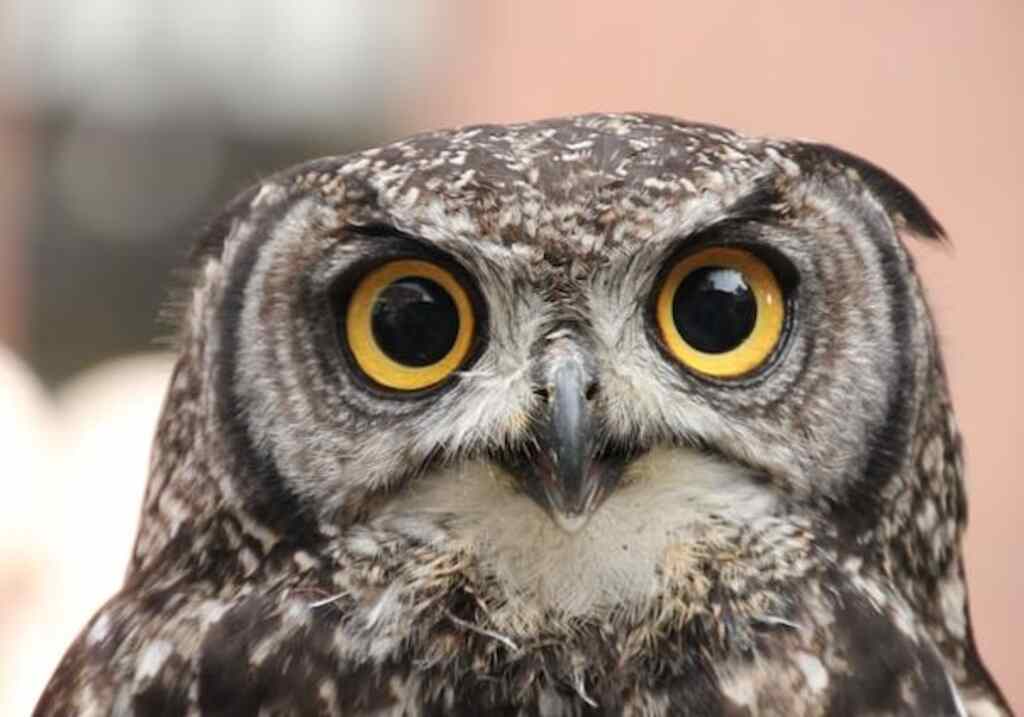Can Owls Move Their Eyes? The short answer: no. But don’t worry, they’re not stuck staring straight ahead like stone statues. In fact, they have a unique ability to turn their heads a whopping 270 degrees!
So, why can’t they move their eyes? Join us as we dive into the fascinating world of owl anatomy and discover the secrets behind their incredible vision.
Table of Contents
- 1 A Brief Introduction to Owls
- 2 The Importance of Owl Eyesight
- 3 Can Owls Move Their Eyes?
- 4 Anatomy of Owl Eyes
- 5 Summary of Key Points:
- 6 Implications for Future Research on Owl Eyesight:
- 7 FAQs: Can Owls Move Their Eyes
- 7.1 Can owls move their eyes in their sockets?
- 7.2 Do owls have binocular vision like humans?
- 7.3 Can owls move their eyes independently like chameleons?
- 7.4 Do all owl species have the same eye movement abilities?
- 7.5 How do owls keep their focus on a target when flying at high speeds?
- 7.6 Do owls have a fovea like humans?
- 7.7 How does an owl’s eye movement help it adapt to different environments?
- 8 Final Thoughts on the Remarkable Abilities of Owls:
- 9 Author
A Brief Introduction to Owls
For centuries, humans have been fascinated by owls, the intriguing creatures with their distinctive hoots and haunting calls. Owls have been the subject of myths, legends, and scientific studies, and there are over 200 species of owls known to exist today, each with its unique characteristics and adaptations.
One of the most impressive features of owls is their exceptional eyesight. Owls are renowned for having some of the best eyesight among all birds, with sharp visual acuity that enables them to hunt effectively even in low light conditions.
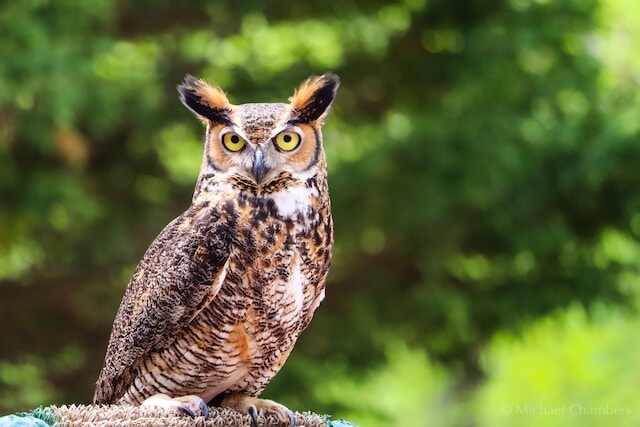
The Importance of Owl Eyesight
Owl eyesight is critical to their survival in the wild. Because many owl species are nocturnal hunters, they rely on their keen vision to locate prey in low light conditions when other animals cannot see well.
But even during the day, owl vision is exceptional compared to other birds – some species can see up to ten times better than humans! Owl eyesight is also important for other reasons beyond hunting.
For example, some species rely on visual cues to identify potential mates during breeding season or navigate through complex environments such as dense forests or urban areas.
Can Owls Move Their Eyes?
This brings us to our main question: Can owls move their eyes? The answer is yes and no – while owl eye movement is limited compared to human eye movement within a socket (they cannot roll their eyeballs around in their heads like we do), they have evolved unique adaptations that allow them to compensate for this limitation.
In the next sections, we will explore owl eye anatomy in greater detail and discuss how they are able to move their eyes and retain their incredible visual abilities.
Anatomy of Owl Eyes
Owls are known for their striking and unique eyes, which are large and forward-facing. These eyes allow for excellent vision in low light conditions, which is necessary for the nocturnal hunting habits of many owl species.
The size and shape of an owl’s eyes are larger than would be expected given their body size, as they take up a significant portion of an owl’s skull.
The placement and movement of owl eyes are also notable. Unlike humans, who have binocular vision with both eyes facing forward, owls’ eyes face forward but are not aligned with each other.
Instead, one eye is placed higher on the skull than the other, allowing for a wider range of vision without having to move the head as much.
This placement also allows for better depth perception – something that is crucial for owls when hunting prey in dimly lit environments.
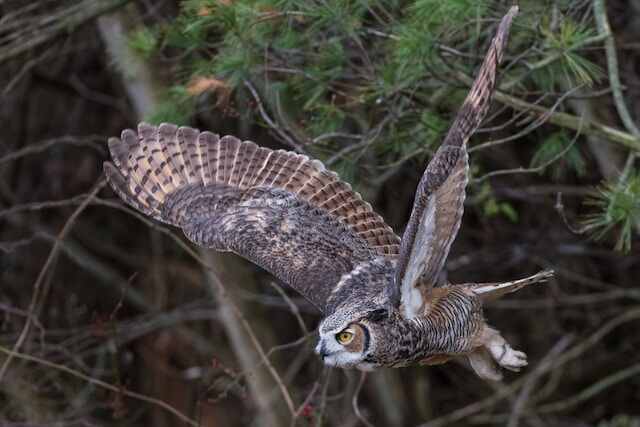
Comparison to Human Eye Anatomy
In terms of anatomy, there are several key differences between owl eyes and human eyes. While humans have flat corneas that focus light directly onto the retina at the back of the eye, owls have much larger corneas that act like lenses to focus more light onto their retinae.
Additionally, while humans have muscles that can move our eyeballs within our sockets to adjust our gaze, owls’ eye sockets do not allow for much movement beyond small adjustments.
Overall, the anatomy of owl eyes reflects their unique adaptations to their environment and hunting habits.
Their large size and shape provide excellent low-light vision, while also allowing them to see a wide range without having to move their heads too much.
The placement of their forward-facing but not aligned eyes provides enhanced depth perception – all crucial adaptations for successful nocturnal predators like owls.
Comparison to Human Eye Anatomy
| Human Eye | Owl Eye | |
|---|---|---|
| Cornea | Flat | Large and acts as a lens to focus more light |
| Muscles | Can move eyeballs | Eye sockets allow small adjustments only |
| Size | Small | Large, providing excellent low-light vision |
| Shape | Rounded | Forward-facing but not aligned, enhancing depth perception |
Eye Movement in Owls
Owls’ eyes are fixed within their sockets, which means they cannot move their eyes like humans or most other animals. Instead, they have a unique adaptation that allows them to compensate for this limitation.
Owls have an incredible ability to rotate their necks up to 270 degrees, which gives them a wider range of vision than any other bird or mammal. They achieve this by having extra vertebrae in their necks and specialized arteries that allow blood flow even when the neck is twisted.
Despite the advantage of having an almost 360-degree view of their surroundings, owls can’t see straight ahead when their heads are turned around. Therefore, these birds must rotate their heads back to face forward before launching an attack on prey or flying away from danger.
However, this rotation is lightning-fast and requires minimal effort due to the structure of owl necks and muscles. These adaptations provide owls with unparalleled hunting abilities as well as exceptional survival skills in the wild.
Eye Movement in Owls
| Owls’ Eye Movement | |
|---|---|
| Eyes | Fixed within sockets, but have overlapping fields of vision for depth perception |
| Neck | Can rotate up to 270 degrees, giving a wider range of vision than any other bird |
| Rotation | Lightning-fast and requires minimal effort due to the structure of owl necks |
A Unique Adaptation for Depth Perception
Another remarkable feature of owl eye movement is how it contributes to depth perception. The fixed position of owls’ eyes would ordinarily impede depth perception, but they have a unique adaptation to overcome this limitation.
Their eyes are placed very close together on the front of their faces and slightly tilted downwards towards the beak, which creates overlapping fields of vision known as binocular vision.
This design allows both eyes to focus on one point at the same time creating depth perception allowing the owl to accurately judge distance and size, giving them precise aim while hunting prey or avoiding obstacles while flying at night.
In addition to having superior depth perception compared with other birds or mammals, owls also have superior low-light vision due to various adaptations within their eyes such as larger lenses and more rod cells than cone cells in the retina, making them ideal nocturnal hunters.
A Unique Adaptation for Depth Perception
| Owl Eye Depth Perception | |
|---|---|
| Vision | Overlapping fields of vision create binocular vision and enhance depth perception |
| Adaptation | Compensates for fixed position of eyes, allowing for accurate judgment of distance and size |
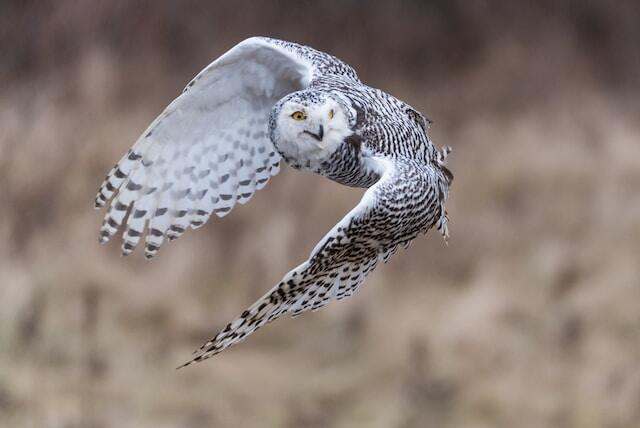
Advantages of Owl Eye Movement
Enhanced Hunting Abilities
Owls are known for their exceptional hunting skills, which are largely attributed to their unique eye movements. Unlike humans and most other animals, owls have binocular vision, which means that both of their eyes work together to focus on a single point. This allows them to accurately judge distances and have better depth perception.
Additionally, because owls can’t move their eyes very much in their sockets, they have developed the ability to rotate their necks up to 270 degrees in either direction. This gives them an incredibly wide field of view that allows them to spot prey with ease.
Owls also have the ability to lock onto a target and keep it in focus even when they’re flying at high speeds or in low light conditions. Their eyes are equipped with densely packed rod cells, which allow them see well in dim lighting.
Additionally, because owls don’t have a fovea (a small area in the retina responsible for sharp central vision), they rely on motion detection and peripheral vision when hunting. This means that even if an owl can’t see its prey clearly, it can still track its movement and adjust its trajectory accordingly.
Table for Enhanced Hunting Abilities:
| Hunting Abilities | Description |
|---|---|
| Binocular Vision | Owls have two eyes that work together to focus on a single point, allowing them to accurately judge distances and have better depth perception. |
| Neck Rotation | Owls can rotate their necks up to 270 degrees in either direction, giving them a wide field of view and the ability to spot prey with ease. |
| Target Lock | Owls can lock onto a target and keep it in focus even when flying at high speeds or in low light conditions, thanks to densely packed rod cells in their eyes. |
| Motion Detection | Owls rely on motion detection and peripheral vision when hunting, meaning they can still track prey even if they can’t see it clearly. |
Increased Awareness and Survival Skills in the Wild
For owls living in the wild, having superior eye movement is critical for survival. Owls must be able to constantly monitor their surroundings for potential predators or prey while remaining hidden from danger themselves.
The ability to rotate their necks and widen their field of view gives owls an advantage over other predators like foxes or wolves who might only be able see what’s directly ahead of them.
In addition to avoiding danger, having good situational awareness is also essential for finding food sources as well as mates during breeding season. Owls rely heavily on visual cues when searching for food such as small rodents or insects.
The ability to quickly scan the environment and locate prey is crucial for their survival. Similarly, during mating season, owls must be able to spot potential mates from a distance and display appropriate courtship behaviors in order to successfully reproduce.
Table for Increased Awareness and Survival Skills in the Wild:
| Survival Skills | Description |
|---|---|
| Situational Awareness | Owls must constantly monitor their surroundings for potential predators or prey while remaining hidden from danger themselves. |
| Visual Cues | Owls rely heavily on visual cues when searching for food or mates. |
| Scanning Ability | Owls must be able to quickly scan their environment and locate prey or potential mates from a distance. |
| Adaptability | Owls must be able to adapt to different environments in order to survive. |
Adaptation to Different Environments
Owls are found in a wide variety of habitats, from dense forests to open fields, which means they must be able to adapt their hunting techniques accordingly.
For example, owls that live in open environments like grasslands or deserts must be able to spot prey from long distances, while owls living in dense forests must have the ability to navigate through complex terrain with limited visibility.
Because of their unique eye movements, owls are able to adapt their hunting techniques based on the environment they’re living in.
Owls that live in open environments rely more heavily on visual cues for hunting whereas owls that live in dense forests use a combination of hearing and sight when searching for prey.
Additionally, because different species of owl have slightly different eye structures and abilities, they may specialize in different hunting techniques depending on where they live.
Table for Adaptation to Different Environments:
| Adaptation to Environment | Description |
|---|---|
| Hunting Techniques | Owls adapt their hunting techniques based on the environment they live in. |
| Open Environments | Owls living in open environments rely more heavily on visual cues for hunting. |
| Forest Environments | Owls living in dense forests use a combination of hearing and sight when searching for prey. |
| Species Specialization | Different species of owl may specialize in different hunting techniques depending on where they live. |
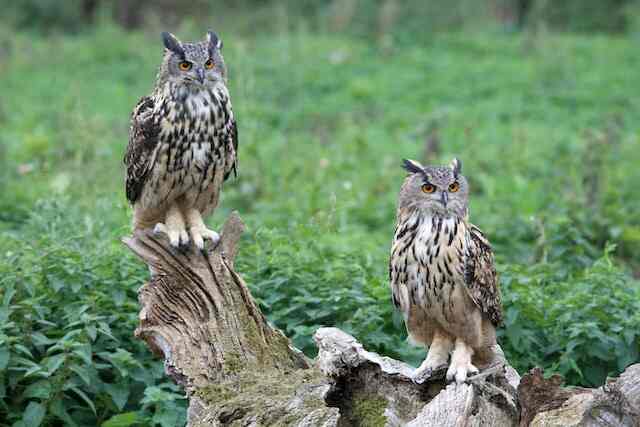
Summary of Key Points:
Owls have impressive eyesight that allows them to easily hunt, navigate and survive in the wild. Their large eyes are fixed in place, but they can rotate their necks up to 270 degrees to compensate for their limited eye movement. Owls also have a unique adaptation that enables them to perceive depth accurately while flying at high speeds.
Despite their remarkable abilities, there is still much we do not know about owl eyesight. Researchers are continuously studying owl vision and eye movement patterns in order to better understand how this amazing bird sees the world around them.
Implications for Future Research on Owl Eyesight:
The study of owl eyesight has far-reaching implications for both wildlife conservation and technological advancements. By understanding how owls perceive the world around them, researchers can develop new strategies for wildlife management and species conservation efforts.
Owl vision research may also lead to breakthroughs in technology such as advanced surveillance systems, robotics, and autonomous vehicles that utilize similar visual strategies as owls when navigating through complex environments.
FAQs: Can Owls Move Their Eyes
Can owls move their eyes in their sockets?
Not much. Unlike humans, owls have fixed eye sockets, but they compensate for this by having flexible necks that can rotate up to 270 degrees in either direction, giving them a wider field of vision.
Do owls have binocular vision like humans?
Yes, owls have binocular vision, which means that both of their eyes work together to focus on a single point. This allows them to accurately judge distances and have better depth perception.
Can owls move their eyes independently like chameleons?
No, owls cannot move their eyes independently. They compensate for this by having the ability to turn their heads nearly all the way around, which allows them to scan their environment without moving their body.
Do all owl species have the same eye movement abilities?
No, different species of owl have slightly different eye structures and abilities, which allows them to specialize in different hunting techniques depending on where they live.
How do owls keep their focus on a target when flying at high speeds?
Owls have densely packed rod cells in their eyes that allow them to see well in dim lighting. This enables them to lock onto a target and keep it in focus even when flying at high speeds or in low light conditions.
Do owls have a fovea like humans?
No, owls do not have a fovea, which is a small area in the retina responsible for sharp central vision. Instead, they rely on motion detection and peripheral vision when hunting.
How does an owl’s eye movement help it adapt to different environments?
Owls are able to adapt their hunting techniques based on the environment they’re living in. For example, owls that live in open environments rely more heavily on visual cues for hunting, whereas owls that live in dense forests use a combination of hearing and sight when searching for prey.
Final Thoughts on the Remarkable Abilities of Owls:
Owls are truly remarkable creatures with incredible adaptations that allow them to thrive in a variety of environments. Their unique eye structure and movement patterns have been developed over millions of years of evolution, resulting in an extremely effective method of hunting and survival.
As humans continue to study owl eyesight and learn from their remarkable abilities, it is important that we remain vigilant in our efforts to protect these amazing birds from habitat destruction, pollution, poaching, and other threats.
With continued research into owl anatomy and behavior patterns, we can gain a greater appreciation for these majestic creatures while also working towards protecting their future survival.
Related Post: Can Birds Move Their Eyes? (The Shocking Truth!)

